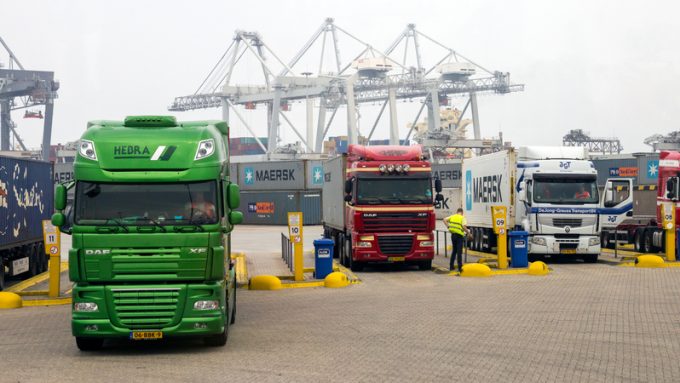Container spot rates have peaked as all major trades see prices fall
There was more evidence in this week’s container port freight markets that peak prices on ...
TFII: SOLID AS USUALMAERSK: WEAKENINGF: FALLING OFF A CLIFFAAPL: 'BOTTLENECK IN MAINLAND CHINA'AAPL: CHINA TRENDSDHL: GROWTH CAPEXR: ANOTHER SOLID DELIVERYMFT: HERE COMES THE FALLDSV: LOOK AT SCHENKER PERFORMANCEUPS: A WAVE OF DOWNGRADES DSV: BARGAIN BINKNX: EARNINGS OUTODFL: RISING AND FALLING AND THEN RISING
TFII: SOLID AS USUALMAERSK: WEAKENINGF: FALLING OFF A CLIFFAAPL: 'BOTTLENECK IN MAINLAND CHINA'AAPL: CHINA TRENDSDHL: GROWTH CAPEXR: ANOTHER SOLID DELIVERYMFT: HERE COMES THE FALLDSV: LOOK AT SCHENKER PERFORMANCEUPS: A WAVE OF DOWNGRADES DSV: BARGAIN BINKNX: EARNINGS OUTODFL: RISING AND FALLING AND THEN RISING

European road freight rates registered their first annual decline last year, after the pandemic excoriated demand across the continent.
According to new data from Transport Intelligence and digital road freight marketplace Upply, road freight rates across Europe fell on average by 1.6%, giving a benchmark rate of €1,060 ($1,271), or €1.55/km.
“After four years of data collection, this is the first registered price fall,” says a new report from the firms. “In 2019 a 1.5% increase in rates followed a 4.4% jump in 2018.”
It says the decline was largely due to lower demand across Europe as the pandemic unfolded, a decline that would have been worse had it not been offset by reduced supply and border crossing issues.
However, there were tentative signs of a recovery in the fourth quarter, and the analysts warn that shippers could be looking at severe price increases this year.
“We anticipate a steady recovery in 2021, driven by an expected increasing transport demand from Q221. Key factors to monitor are fuel price, EU economic growth and balance between transport offer and demand,” said Thomas Larrieu, Upply’s chief data & research officer.
On a webinar yesterday, Upply road transport expert William Beguerie added that other factors that could spell rate increases were likely to come from problems at the Channel, as a result of Brexit; a resumption of driver shortages; structural changes in markets served by hauliers, such as the decline of traditional retail models and the transformation of automotive supply chains; and the application of the EU’s mobility package, which continues to be fiercely resisted by many eastern and central European countries with significant numbers of drivers.
A key clause of the mobility package is that drivers have the right to return home every three to four weeks, which east and central European haulage bosses argue would trash their economic operating models.
This will be the first full year of the mobility package and Maciej Wroński, president of the Association of Polish Employers in Transportation and Logistics, said productivity could drop by around 20%, leading to carriers collectively seeing costs rise by €1.3bn-€2bn, “and that is why these countries continue to fight the legislation”.
Mr Beguerie said: “Higher prices might be needed to offset cost increases, but I believe the most pressing issue will be the risk of insolvencies – many SME hauliers are at risk of going bust.”
In the fourth quarter last year, two lanes covered by TI-Upply road freight indices bucked the trend of declining rates – UK-continental Europe and Rotterdam-Duisburg.
A burst of stockpiling in the weeks leading to the official end of the Brexit transition period saw rates finish the year on a high and, despite lower demand this year, prices are expected to continue to remain high as the initial “teething problems” to cross-Channel trade become permanent administrative burdens.
“The consequences of Brexit are not fully clear yet,” Mr Beguerie said.
“As the UK implements border checks from the middle of the year, there continue to be questions over market access, cabotage, transport of live animals, phytosanitary checks, insurance, customs declarations and expected IT problems… what is clear is that nothing is clear, but we expect reduced capacity and higher prices, regardless of demand,” he added.
Fourth-quarter rates also increased on Rotterdam-Duisburg, largely, said Ti quantitative analyst Andy Ralls, because Germany’s manufacturing recovery was far quicker than its European peers, and its factories were forced to source goods from outside the bloc.
“We saw rates on this lane up by 3.4% as a result of the changing relationship of German manufacturing. It looks like Germany has been sourcing more from outside the EU, with China as a leading market, and we expect to see further increases on this lane – although if there is a stronger European recovery, the sourcing could switch back,” he said.
Comment on this article